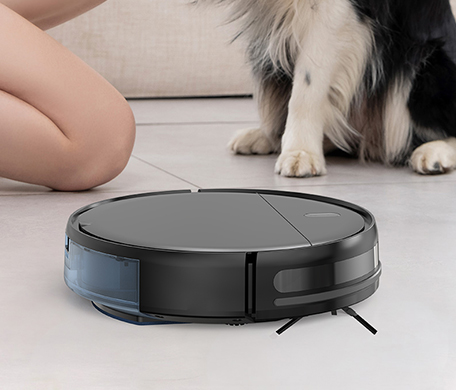With the development of technology, more and more smart technologies are being used in our daily lives, bringing intelligent and convenient experiences. One of them is the smart cleaning robot, which has become an essential smart appliance for household life due to its practicality and ease of use.
Although the smart cleaning robot is convenient to use, many people may not know its working principle. Generally speaking, the function of the smart cleaning robot is to "sweep + vacuum", and it can only do the cleaning and hygiene work on the ground. With the artificial intelligence system installed, it can operate autonomously through navigation and sensors, which can fully free up your hands. The disadvantage is that it is easy to be trapped by ground obstacles, so it is best to use it on the ground without messy toys, flower pots and other obstacles that may hinder its operation.
Laser navigation is a technology that measures the distance and location between the machine body and environmental objects through a laser emitter. This technology has an early start, fast response, high precision, and stable performance. It is the most mature navigation technology. However, this navigation also has a major flaw, which is unable to detect highly reflective objects such as glass mirrors and floor-to-ceiling windows, as it cannot receive scattered light when the laser is projected onto these objects. However, many smart cleaning robot merchants have solved this problem perfectly by installing a glass detection sensor inside the machine body.
Simply put, visual navigation simulates human vision by using visual sensors to collect environmental information to obtain position information, direction, and other information. Visual navigation has strong scene recognition ability. As a new navigation solution in recent years, visual navigation will become the mainstream navigation of the next generation.
Although visual navigation is powerful enough, it also has certain shortcomings, such as lower accuracy and stability than laser navigation. In some simple environments, laser navigation is better than visual navigation. However, in complex environments, the advantages of visual navigation can be reflected. In summary, the visual navigation of a smart cleaning robot has advantages in obstacle avoidance and interaction, but still needs improvement in accuracy and stability.
The gyroscope mainly judges the walking direction of the robot and can accurately locate the XY coordinates in conjunction with the indoor navigation positioning system and the operation status of the walking motor. When bypassing obstacles, it records the bypass direction to avoid the robot from repeating the cleaning process and improving the cleaning efficiency. The software calculates the robot's walking route and can record the itinerary. Through the floor cleaning path coverage algorithm, it completes the cleaning plan and saves it. During the movement, it can detect the robot's horizontal rotation and position adjustment. When the smart cleaning robot needs to be charged, it can quickly return to the charging station through its own coordinates. After charging, it can continue the cleaning process by returning to the cleaning area through the itinerary record, greatly improving efficiency. For concave or dead corner terrain, recording the itinerary during the cleaning process is helpful to complete the cleaning efficiently.


